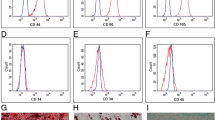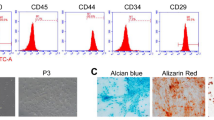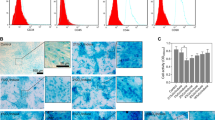Abstract
Mesenchymal stem cells (MSCs) are candidates for the regeneration of articular cartilage as they possess the potential for chondrogenic differentiation. MSCs are easily obtained and expanded in vitro. Specific microRNAs (miRNAs) that regulate chondrogenesis have yet to be identified and the mechanisms involved remain to be defined. The miRNAs regulate biological processes by binding target mRNA to reduce protein synthesis. In this study, we show that expression of miR-99a and miR-125b-3p were increased during early chondrogenic differentiation of MSCs (rMSCs) derived from the Norwegian brown rat (Rattus norvegicus). MiR-99a knockdown promoted proteoglycan deposition and increased the expression of ACAN and COL2A1 during early chondrogenic differentiation. MiR-99a knockdown promoted early chondrogenic differentiation of rMSCs. A dual-luciferase reporter gene assay showed that miR-99a targeted a putative binding site in the 3’-UTR of bone morphogenetic protein (BMP) receptor type 2 (BMPR2). Overexpression of miR-99a reduced the expression levels of BMPR2 protein. The expression of total p38 and p-p38 increased at 7 and 14 days during early chondrogenic differentiation of rMSCs. Reduction in levels of total p38 and p-p38 protein followed miR-99a overexpression during early chondrogenic differentiation of rMSCs. BMPR2 silencing reversed the effects of miR-99a inhibition on proteoglycan deposition and protein expression of ACAN, COL2A1, total p38 and p-p38 during early chondrogenic differentiation of rMSCs. In conclusion, the findings of these in vitro studies in rat MSCs support a role for miR-99a as a negative regulator of early chondrogenic differentiation by directly targeting the BMPR2 gene at an early stage.






Similar content being viewed by others
References
Alvarez-Garcia I, Miska EA (2005) MicroRNA functions in animal development and human disease. Development 132:4653–4662
Andres-Bergos J, Tardio L, Larranaga-Vera A, Gomez R, Herrero-Beaumont G, Largo R (2012) The increase in O-linked N-acetylglucosamine protein modification stimulates chondrogenic differentiation both in vitro and in vivo. J Biol Chem 287:33615–33628
Barry F, Boynton RE, Liu B, Murphy JM (2001) Chondrogenic differentiation of mesenchymal stem cells from bone marrow: differentiation-dependent gene expression of matrix components. Exp Cell Res 268:189–200
Bartel DP (2004) MicroRNAs: genomics, biogenesis, mechanism, and function. Cell 116:281–297
Braem K, Luyten FP, Lories RJ (2012) Blocking p38 signalling inhibits chondrogenesis in vitro but not ankylosis in a model of ankylosing spondylitis in vivo. Ann Rheum Dis 71:722–728
Buechli ME, Lamarre J, Koch TG (2013) MicroRNA-140 expression during chondrogenic differentiation of equine cord blood-derived mesenchymal stromal cells. Stem Cells Dev 22:1288–1296
Caplan AI, Bruder SP (2001) Mesenchymal stem cells: building blocks for molecular medicine in the 21st century. Trends Mol Med 7:259–264
Csaki C, Schneider PR, Shakibaei M (2008) Mesenchymal stem cells as a potential pool for cartilage tissue engineering. Ann Anat 190:395–412
Freyria AM, Courtes S, Mallein-Gerin F (2008) Differentiation of adult human mesenchymal stem cells: chondrogenic effect of BMP-2. Pathol Biol 56:326–333
Gomoll AH, Minas T (2014) The quality of healing: articular cartilage. Wound Repair Regen 1:30–38
Hou C, Yang Z, Kang Y, Zhang Z, Fu M, He A, Liao W (2015) MiR-193b regulates early chondrogenesis by inhibiting the TGF-beta2 signaling pathway. FEBS Lett 589:1040–1047
Ito A, Nagai M, Tajino J, Yamaguchi S, Iijima H, Zhang X, Aoyama T, Kuroki H (2015) Culture temperature affects human chondrocyte messenger RNA expression in monolayer and pellet culture systems. PLoS ONE 10
Jiang C, Ma P, Ma B, Wu Z, Qiu G, Su X, Xia Z, Ye Z, Wang Y (2015) Plasma-derived fibronectin stimulates chondrogenic differentiation of human subchondral cortico-spongious progenitor cells in late-stage osteoarthritis. Int J Mol Sci 16:19477–19489
Jin EJ, Lee SY, Choi YA, Jung JC, Bang OS, Kang SS (2006) BMP-2-enhanced chondrogenesis involves p38 MAPK-mediated down-regulation of Wnt-7a pathway. Mol Cells 22:353–359
Lee S, Yoon DS, Paik S, Lee KM, Jang Y, Lee JW (2014) microRNA-495 inhibits chondrogenic differentiation in human mesenchymal stem cells by targeting Sox9. Stem Cells Dev 23:1798–1808
Lewis BP, Burge CB, Bartel DP (2005) Conserved seed pairing, often flanked by adenosines, indicates that thousands of human genes are microRNA targets. Cell 120(1):15–20
Li J, Zhao Z, Liu J, Huang N, Long D, Wang J, Li X, Liu Y (2010) MEK/ERK and p38 MAPK regulate chondrogenesis of rat bone marrow mesenchymal stem cells through delicate interaction with TGF-beta1/Smads pathway. Cell Prolif 43:333–343
Lin EA, Kong L, Bai XH, Luan Y, Liu CJ (2009) miR-199a, a bone morphogenic protein 2-responsive MicroRNA, regulates chondrogenesis via direct targeting to Smad1. J Biol Chem 284:11326–11335
Liu F, Ventura F, Doody J, Massague J (1995) Human type II receptor for bone morphogenic proteins (BMPs): extension of the two-kinase receptor model to the BMPs. Mol Cell Biol 15:3479–3486
Luyten FP, Vanlauwe J (2012) Tissue engineering approaches for osteoarthritis. Bone 51:289–296
Moyer RF, Hunter DJ (2015) Osteoarthritis in 2014: Changing how we define and treat patients with OA. Nat Rev Rheumatol 11:65–66
Nakamura K, Shirai T, Morishita S, Uchida S, Saeki-Miura K, Makishima F (1999) p38 mitogen-activated protein kinase functionally contributes to chondrogenesis induced by growth/differentiation factor-5 in ATDC5 cells. Exp Cell Res 250:351–363
Pittenger MF (2008) Mesenchymal stem cells from adult bone marrow. Methods Mol Biol 449:27–44
Pittenger MF, Mackay AM, Beck SC, Jaiswal RK, Douglas R, Mosca JD, Moorman MA, Simonetti DW, Craig S, Marshak DR (1999) Multilineage potential of adult human mesenchymal stem cells. Science 284:143–147
Thompson BJ, Cohen SM (2006) The Hippo pathway regulates the bantam microRNA to control cell proliferation and apoptosis in Drosophila. Cell 126:767–774
Yang B, Guo H, Zhang Y, Chen L, Ying D, Dong S (2011a) MicroRNA-145 regulates chondrogenic differentiation of mesenchymal stem cells by targeting Sox9. PLoS ONE 6:20
Yang B, Guo H, Zhang Y, Dong S, Ying D (2011b) The microRNA expression profiles of mouse mesenchymal stem cell during chondrogenic differentiation. BMB Rep 44:28–33
Acknowledgments
The authors declare they have no competing interests.
Author information
Authors and Affiliations
Corresponding author
Rights and permissions
About this article
Cite this article
Zhou, X., Wang, J., Sun, H. et al. MicroRNA-99a regulates early chondrogenic differentiation of rat mesenchymal stem cells by targeting the BMPR2 gene. Cell Tissue Res 366, 143–153 (2016). https://doi.org/10.1007/s00441-016-2416-8
Received:
Accepted:
Published:
Issue Date:
DOI: https://doi.org/10.1007/s00441-016-2416-8




